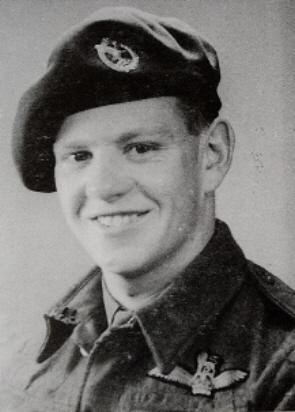My Uncle, William Kenneth Marfleet, the youngest son of Jesse and Dora Marfleet, was born in September, 1919, in a colliery cottage at Deggs Fields, Longton, nr Stoke on Trent, Staffordshire. His father was foreman blacksmith at the local Florence Colliery.
A few years later, the family moved to Bentilee where Billy attended Bucknell Council School until the age of fourteen. He did not grow into the tallest of young men and was known as 'Little Billy'. After leaving school, he worked for a painter and decorator but left this to be apprenticed as a dental technician.
When war was declared, Billy received his call-up papers and applied to the RAF. He had a passion to fly and was bitterly disappointed when, despite passing every other test and examination, he was considered too short to be a pilot.
The Army Dental Corps was happy to take him and so off he went to Basic Training. He came through this with no difficulty and actually grew! His family and friends could not believe the giant who came home on leave.
Posted to 319 Army Dental Centre on Christmas Eve, 1941, Billy soon became disillusioned with his desk job. He wanted some action. His chance came the following year when a new regiment, the Glider Pilot Regiment, was inaugurated.
He was transferred to the Army Air Corps and posted to 2nd Wing Glider Pilot Regiment. After the initial training period at Tilshead, he went to RAF Booker for flying training. During this time he was promoted to Corporal. In January, 1943, following successful completion of his flying course, Billy was posted to 1 Glider Training School at Croughton. It was here that he first began to show the flying skills that would later cause him to be held in high regard by his colleagues.
In March 1943, General Frederick Browning presented Billy with his Army Flying Badge – his 'wings'. It was a very proud occasion for him to receive these from so great a soldier. It was also at this time that Billy was promoted to sergeant. He was very proud of his stripes. His youngest sister remembers painting them with white stationer's ink.
His final posting was to the GPR's 'A' Squadron at Harwell. In early April, 1944, Major Griffith, the Squadron CO, called the pilots together to tell them about a special mission which would require volunteers. A flying competition was used to make the final selection. A friend of Billy's later recalled that event:
'I can well remember the competition that settled Bill's fate. A spot was placed on the runway and a small sum of money was offered to those who touched down nearest to the mark. The first four crews were in due course detailed for the night landing. I must have been very naive for it wasn't until long after that I realised what the competition was all about.'
Billy and his friend and co-pilot, Vic Haines were now part of Operation Tonga and tasked to fly to Varaville, in support of the D-Day attack on the Merville Battery by men of the British 9th Parachute Battalion.
Billy's days now revolved around exercises. All D-Day crews flew countless exercise flights, but the crews who were to fly during the night were put through their paces in both real and simulated night flying. As 5 June drew closer, Billy spent more time away from barracks. Under armed escort he visited Netheravon where he was able to see the constantly updated model of the landing sites and the film produced to show the flight to Normandy during night-time.
Final preparations were made with Vic Haines, his tug pilot, Flying Officer Christopher Lawson and the glider's three passengers: CQMS Albert Davies (9th Parachute Bn),Bombardier William Sidney (4th Airlanding Anti-Tank Bty RA) and Driver John Lunn (716 (Airborne) Lt Coy RASC). Billy spent 5 June gathering equipment, checking his load (jeep, trailer, 4 bikes, 2 bridging sections and several Bangalore Torpedoes) and hearing final briefings. With the other seven pilots he enjoyed a huge meal of bacon and eggs before being taken by truck (they had always walked before) to his Horsa glider, Chalk No. 67.
Hooked up to Albermarle V1746, Chalk 67 rolled along the runway shortly before 11.30pm. Billy, as first pilot, flew the glider to the assembly point over Worthing. Some miles off the Normandy coast, deteriorating weather and increasingly thick cloud made flying 'on station' very difficult. As V1746 and Chalk 67 entered a particularly thick section of cloud the towrope broke and the glider crashed into the English Channel, killing all on board.
S/Sgt Billy Marfleet's grave is in Bayeux Military Cemetery (X.J.17) and that of Sgt Vic Haines in Abbeville Communal Extension (VI.K.1). Their passengers are buried in Ranville War Cemetery: CQMS Albert Davies VA.K.2; Bdr William Sidney VA.E.5; Dvr John Lunn IX.A.34.


Latest Comments
There are currently no comments for this content.
Add Comment
In order to add comments you must be registered with ParaData.
If you are currently a ParaData member please login.
If you are not currently a ParaData member but wish to get involved please register.